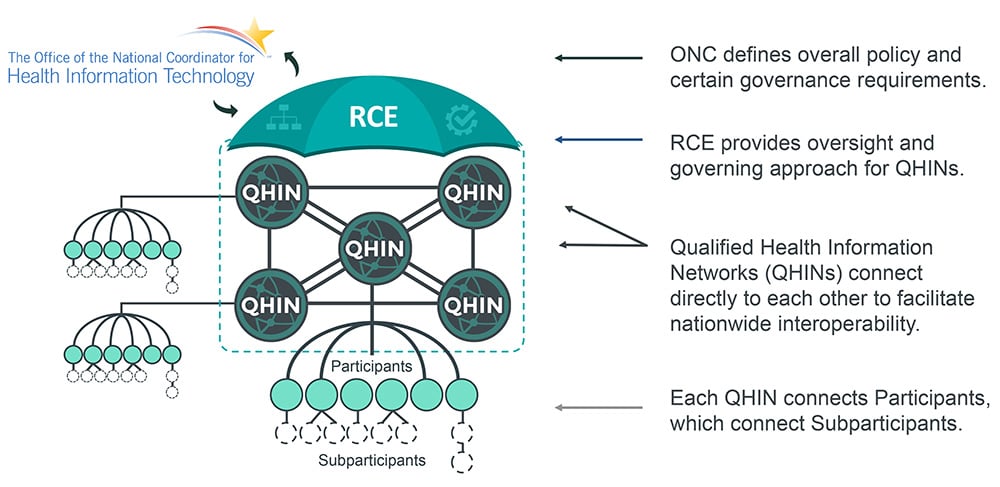TEFCA: A Better User Experience for Exchanging Public Health Data
November 13, 2023 | Lillian Colasurdo, Alex Woodward
 The ways we collect, manage, analyze, and share data used for healthcare and public health decision-making have advanced considerably over the past decade. At the same time, mechanisms supporting secure data exchange have been siloed and largely driven by private business needs, placing a heavy burden on the healthcare providers and public health agencies who share that data. With the implementation of a new, voluntary approach for health data exchange, that burden could be lessened. Later this year, healthcare entities can begin sharing health data under the Trusted Exchange Framework and Common Agreement, also known as TEFCA.
The ways we collect, manage, analyze, and share data used for healthcare and public health decision-making have advanced considerably over the past decade. At the same time, mechanisms supporting secure data exchange have been siloed and largely driven by private business needs, placing a heavy burden on the healthcare providers and public health agencies who share that data. With the implementation of a new, voluntary approach for health data exchange, that burden could be lessened. Later this year, healthcare entities can begin sharing health data under the Trusted Exchange Framework and Common Agreement, also known as TEFCA.
The 21st Century Cures Act of 2016 called on the Office of the National Coordinator for Health Information Technology (ONC) to develop and implement TEFCA, which aims to facilitate a nationwide system for health data exchange, or a “network of networks,” to increase access to data for a variety of health entities with the goal of improving health outcomes. More specifically, TEFCA’s goals are to:
- Establish a universal governance, policy, and technical floor for nationwide interoperability.
- Simplify connectivity for organizations to securely exchange information to improve patient care, enhance the welfare of populations, and generate health care value.
- Enable people to gather their own healthcare information.
TEFCA may facilitate connections between healthcare providers, payers, public health, members of the public, human service agencies, and technology developers to enable more timely and complete data exchange. Using common data standards, these groups will be able to exchange health data securely and efficiently across states and provider networks. For example, an urgent care provider in Wyoming will quickly and securely be able to access the health records of a visiting patient who resides in and usually receives healthcare in Alabama.
Aside from benefits to individual patient care, there are planned benefits for public health as well. ONC and the Sequoia Project released the Technical Exchange Framework: Principles for Trusted Exchange in January 2022. The Framework is a set of voluntary, guiding principles that health information networks agree to follow—standardization, openness and transparency, cooperation and non-discrimination, privacy, security, and safety, access, equity, and public health.
Public health is one of the six Exchange Purposes under TEFCA, which also include treatment, payment, healthcare operations, government benefits determination, and individual access services (IAS). This means that TEFCA entities, such as Qualified Health Information Networks (QHINs), are optionally permitted to request or respond to sharing data under any of these purposes.
TEFCA and Public Health
Many public health agencies currently rely on point-to-point interfaces for data exchange, such as providers emailing individual flat files to a public health agency. Some rely on health information exchanges (HIEs) that facilitate connections to health care providers, laboratories, and other data providers. By providing a “common baseline of legal and technical requirements for data sharing,” TEFCA may expand available data sources for—and timeliness and completeness of—public health data exchange by helping state governments and local public health agencies:
- Improve access to population health data.
- Advance exchange for Medicaid.
- Facilitate public health reporting.
- Support bidirectional exchange with public health agencies.
- Expedite data exchange for emergency preparedness and response.
- Bolster state-level information exchange initiatives.
TEFCA’s Structure
TEFCA will be operationalized by QHINs, which comprise a network of organizations that work together to exchange health data. QHINs connect with other QHINs to exchange data; these QHINs include Participants and Subparticipants (e.g., providers, payers, public health agencies) who provide the data to be exchanged (Figure 1). There are currently seven Candidate QHINs that are being onboarded with the ONC’s Recognized Coordinating Entity (RCE), the Sequoia Project, with the goal of being ready to exchange data at the end of 2023: CommonWell Health Alliance, eHealth Exchange, Epic Nexus, Health Gorilla, Kno2, KONZA National Network, and Med Allies.
The system aims to allow a participant (e.g., primary care provider) to send an immunization record to QHIN A for an individual. QHIN A may then send the record to QHIN B, which then sends the record on to one of its Participants, such as an Immunization Information System or a public health agency. As participation in TEFCA is voluntary, public health agencies may choose to engage as Participants or Subparticipants to a QHIN, sharing data across QHINs.

The ONC and the Sequoia Project released the QHIN Technical Framework (QTF), which focuses on the technical and functional requirements for interoperability among QHINs, as well as the Common Agreement, which is the contract that the approved QHINs will sign with the RCE, establishing the baseline legal and technical requirements for secure information sharing on a national scale. Updated versions of these documents will be released in 2024.
In its first year, TEFCA will focus on data exchange for Treatment and IAS, but will support the six Exchange Purposes, including public health. With public health exchange on the horizon, health departments can begin considering how TEFCA will impact their existing and future data exchanges processes so they may adjust accordingly and partner with an appropriate QHIN.
Preparing for the New Data Exchange Landscape
Public health agencies can take several steps to begin to ready themselves for the new data exchange landscape.
Compatibility of Requirements
First, review the Common Agreement, QTF, educational materials, and guidance documents provided by the Sequoia Project (public health guidance documents are currently under development). Once reviewed, assess whether current state and local legal requirements are compatible with the new requirements under TEFCA. For example, many jurisdictions will have legal limitations on what information can be collected and shared. These might include laws requiring special treatment of certain types of data like HIV, substance use, or behavioral health. These may also include certain data systems or registries that are opt-in vs. opt-out. After identifying conflicts, health departments may pursue potential legislative or regulatory opportunities to amend existing requirements.
Current Data Exchange Environment
Health agencies can assess what health information is currently being exchanged within their jurisdiction. Some agencies also serve as providers and collect health information for diagnostic and treatment purposes as well as for public health analysis that inform prevention and mitigation measures. Understanding current data exchange processes can help jurisdictions identify use cases for exchange through TEFCA. Moreover, this assessment can identify gaps in current infrastructure so they can plan for upgrades and enhancements that will support participation in TEFCA.
Funding
In addition to identifying legal gaps or roadblocks, consider funding needs and potential new sources such as the Public Health Infrastructure Grant and Medicaid Enterprise Federal Financial Participation (FFP). Technical capabilities may need modernizing and staff may require additional training.
Partnerships with QHINs
Health agencies may need to explore partnerships with a potential QHIN, evaluating each one to ensure they support the unique and specific types of exchange needs of a public health agency as opposed to the needs of a healthcare provider (e.g., exchange of laboratory, case, and vital records data). Additionally, agencies may want to consider existing partnerships with HIEs to leverage existing technologies and data sharing infrastructure.
Interoperability Standards
Health agencies may need to consider how the standards and technology they are currently using or plan to adopt for interoperability may impact their ability to participate in the network. For example, while TEFCA’s current technical architecture allows the QHINs’ use of existing Integrating for Healthcare Enterprise (IHE) standards and profiles, the Sequoia Project has developed a FHIR Roadmap for TEFCA exchange, which will accelerate Fast Healthcare Interoperability Resources (FHIR) adoption across the network in the future. Public health agencies may consider focusing their energies on their future exchange of data via QHINs. While individual QHINs will determine standards required for data exchange with Participants and Subparticipants, Health Departments can begin to implement FHIR-based approaches, which reduce the burden of data exchange on both providers and public health agencies.
Finally, CDC has included TEFCA as one of the core components for advancing interoperability for public health. As part of its Public Health Data Strategy, CDC aims to identify and launch pilots for at least two public health use cases for TEFCA by the end of 2024. Along with other initiatives like North Star Architecture, USCDI and USCDI+, and HL7 FHIR accelerators, the framework established in TEFCA is geared to support the current CDC data modernization initiatives.
For up-to-date information on TEFCA, visit ONC’s HealthITbuzz blog and for more information on TEFCA or to register for educational sessions, visit the RCE website at RCE.SequoiaProject.org.